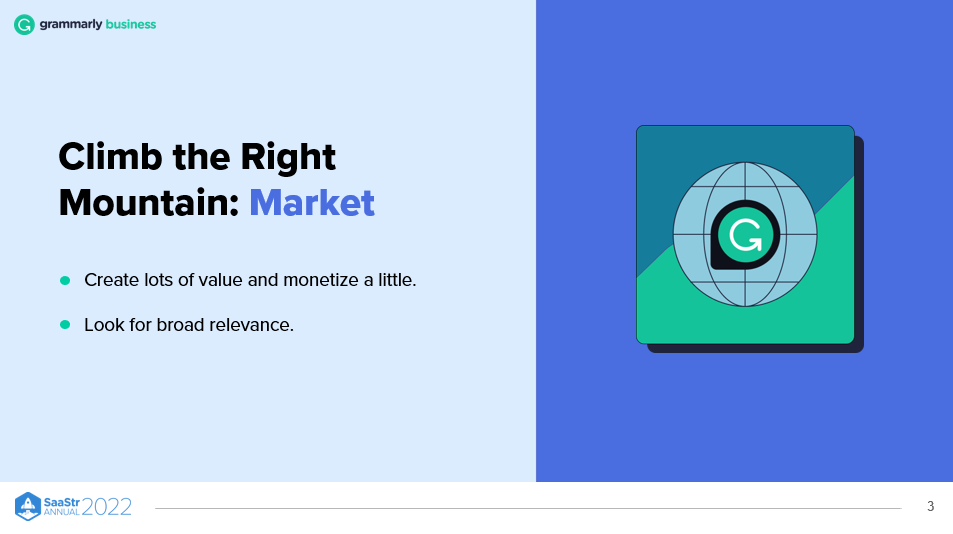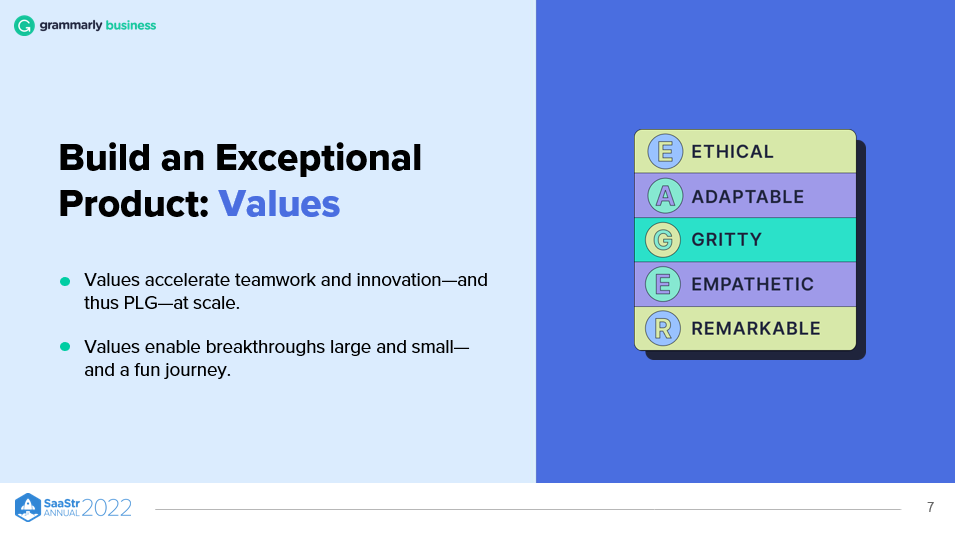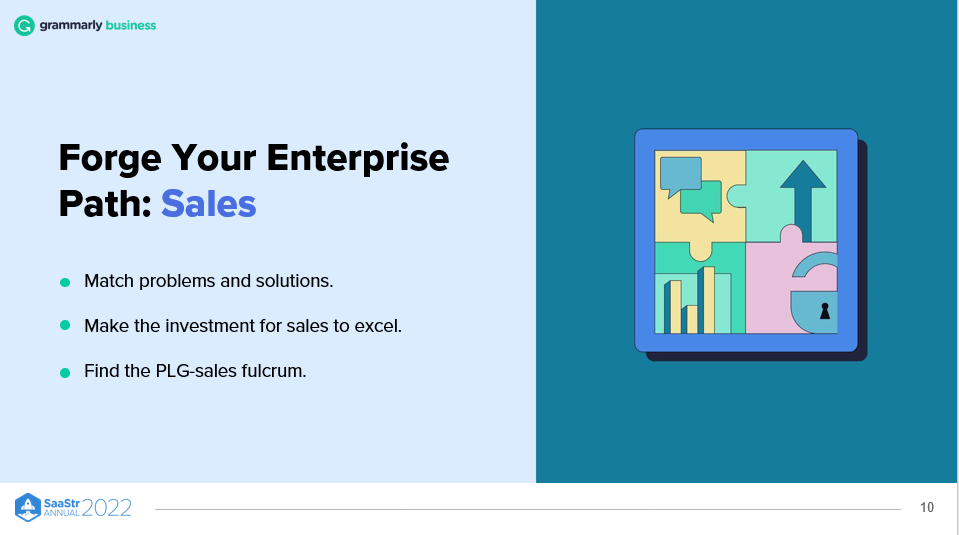AI-powered communication technology is helping people improve the quality and impact of their communication. Grammarly CEO Brad Hoover shares the keys to unlocking product-led growth in the enterprise through learnings from the company’s 13+ year journey helping 50,000 teams and 30 million individuals refine their writing and accomplish their goals.
Climb the right mountain
Whether you’re building an institution or hiking a mountain, ensure it will be a meaningful journey. Create a lot of value and monetize a little on this journey. When you look for broad relevance, focus on two factors: Market and Timing.
Market
If you select a big mission, you need a big market. Think about the problem you’re solving, the value you’re driving, and whether you can create a sustainable institution.
The market you choose should be big enough so you can capture a small piece of it while using your resources to drive your mission.
For Grammarly, communication is a large market because it’s relevant to everyone. The team at Grammarly quantified this by doing a poll with Harris, learning that US businesses lose over a trillion dollars annually to ineffective communication. This fact made it clear to Grammarly that their technology will help enterprises save money lost to ineffective communication.

Timing
When you are bringing something new into the world, ask yourself, ‘why now?’ What is it that makes this the right time to do this thing? If something could have been created before but hasn’t, there’s probably a reason. Start by looking at tectonic shifts in technology or market that facilitate the creation or adoption of your product.
Grammarly launched during the age of cloud computing, big data, and natural language processing algorithms. This created an opening for the brand to introduce its communication system. More recently, with the acceleration of remote work, employers are looking for tools to help teams communicate effectively, which is one of the many use cases for Grammarly.
Figure out if you’re an early mover or a fast follower. This clarity will help you find the right approach for climbing your mountain.
- Early mover. Being an early mover is advantageous as it lets you make mistakes and create something that didn’t exist. The new path you carve will bring value to the world.
- Fast follower. Fast followers can see the mountains being climbed and paths taken, find and follow a path that looks promising and try to win in the last mile.
Build an exceptional product with your users
Put users at the center of product decisions, innovate with a hypothesis-driven approach, then align your business model with user interests. This will help you develop a more aligned product with the messaging, marketing, and sales to unlock product-led growth (PLG). Let your customers set the bar for excellence.
Talk to your users to understand their experiences and seek ambient feedback from social channels, support mechanisms, and other functions. As you grow your user base, use the engagement data to see how users use your product. Draw inferences from what’s going well and what you can improve.
Think of your users as sitting at your conference table. Understand them at a granular level.
Grammarly worked with users to build the first version of the product, helping the brand better understand why users wanted to write accurately. This moved the product beyond spelling and grammar checks to include higher-order points like clarity, conciseness, tone, and more. Grammarly used this to provide an AI-powered communication system that comprehensively augmented communication skills.
While starting with deep user feedback is important, taking a step back is also vital. Use a hypothesis-driven approach to test your next product horizon.
Product-led growth, supported by values

Product-led growth necessitates that the product sells itself. The key is to have people believe in your product. The self-serve funnel of product messaging, marketing, and sales needs to work without a salesperson to communicate to users how your product can solve a problem.
If you launch a product in an enterprise and don’t get many questions, you’ve done something right. Grammarly’s enterprise customers get value in less than thirty days without training, which is a testament to an effective PLG strategy.
Values help accelerate teamwork and innovation—and thus PLG—at scale. As you move beyond the first five people, things break. You need a plan to address these adverse conditions as you scale. Having core values guide everything you do as a company, decisions large and small, is helpful. Values enable breakthroughs.
The next focus point is how you enter the enterprise.
Forge your enterprise path

Consider all stakeholders. Turn end users into champions to land enterprises, and then evolve self-serve motions for the enterprise.
Enterprise consists of end users who can be champions or detractors based on their experience with your product. Users determine app success—if it’s easy to use. If it integrates with other workflows, the impact will be more significant, and retention will be higher.
Many end users become enterprise buyers. For an enterprise, the stakeholder starts with the buyer, but other stakeholders include IT, procurement, and legal functions. Think about how your self-serve funnel aligns with the interests of all stakeholders and how you can address them.
Key Takeaways
Successful sales involves matching a real problem with a real opportunity. When that happens, it creates value out of thin air.
- Climb the right mountain. Consider your chosen mission and ensure you have the resources to deliver on it.
- Build an exceptional product. Focus on users, introduce a PLG motion to grow your user base, and use go-to-market feedback to improve the product.
- Forge your enterprise path. Recognize that you have different stakeholders to serve in large organizations, and each will require different tactics and strategies to win them over.

